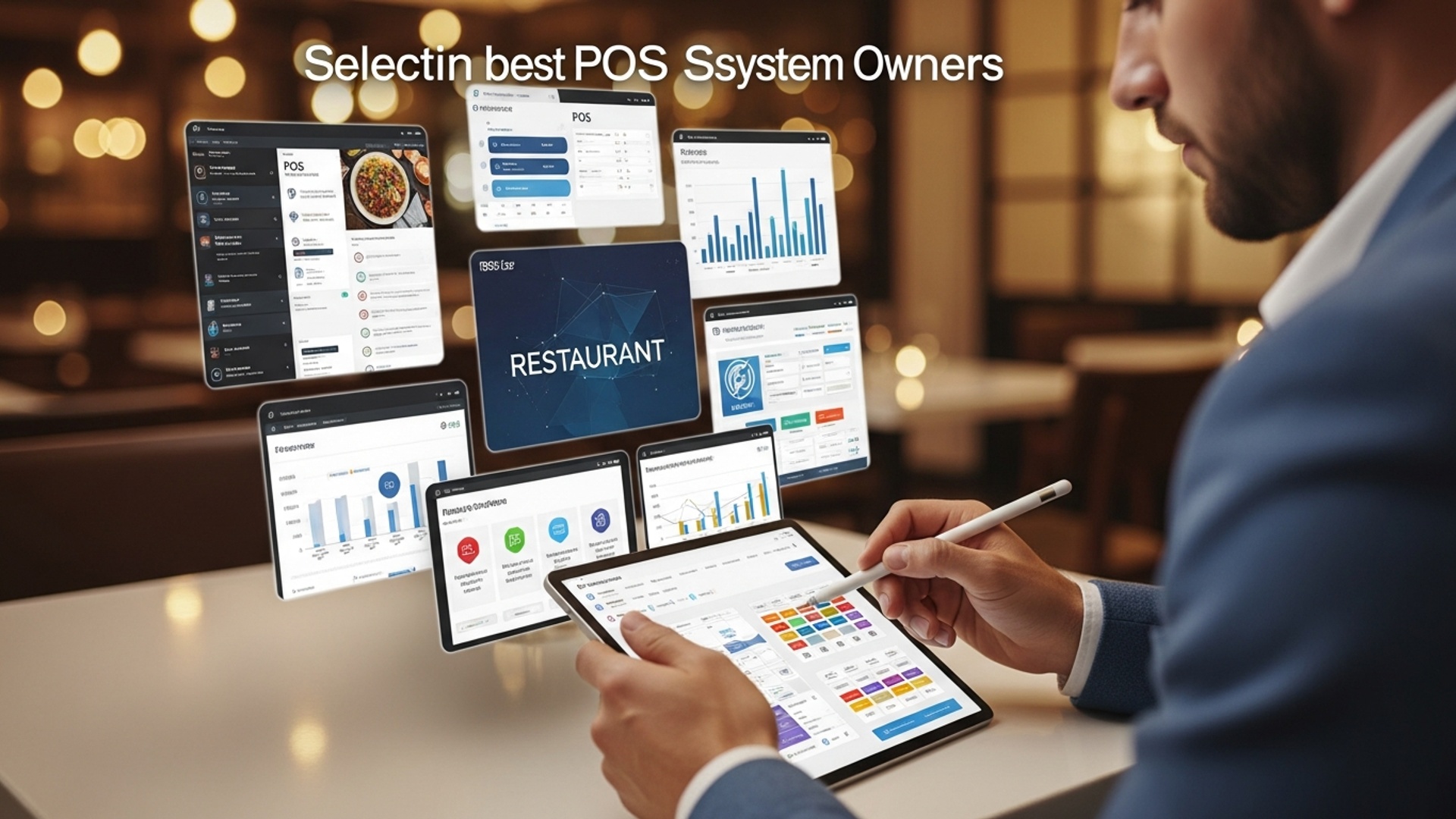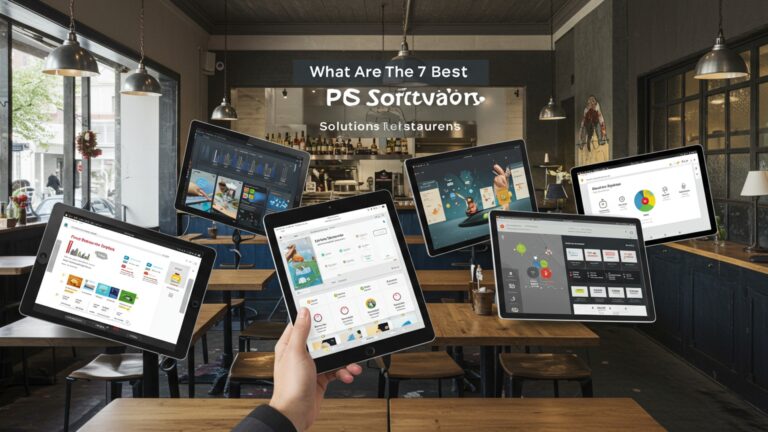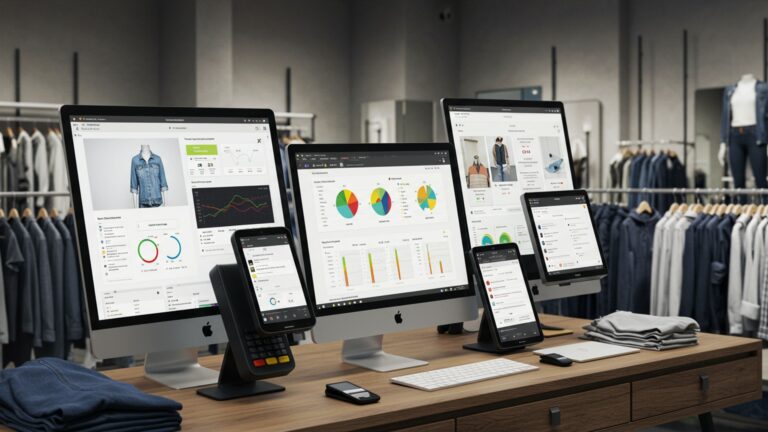How to Select the Best Restaurant POS System 5 Key Steps for Owners
Navigating the complex landscape of modern restaurant operations demands more than just a functional cash register; it requires a robust, integrated Restaurant POS software that drives efficiency and profitability. With consumer expectations shifting towards seamless online ordering, contactless payments. personalized experiences, an outdated or ill-suited system can severely hinder growth, leading to inventory discrepancies, slow table turns. frustrated staff. The right POS acts as the central nervous system for your establishment, connecting everything from kitchen display systems and real-time inventory management to customer relationship tools and employee scheduling. Ignoring current trends like cloud-based platforms and AI-powered analytics means missing crucial opportunities for optimization and competitive advantage in today’s dynamic culinary market. Selecting wisely isn’t just about features; it’s about future-proofing your business.

1. Assessing Your Restaurant’s Unique Operational Needs
The first and most critical step in selecting the best Restaurant POS software is to thoroughly comprehend the specific operational demands and nuances of your establishment. No two restaurants are exactly alike. a one-size-fits-all approach to point-of-sale (POS) systems often leads to inefficiencies and dissatisfaction. Begin by conducting an internal audit of your current operations, identifying pain points. envisioning future growth.
Defining Your Restaurant Type and Service Model
Consider the fundamental characteristics of your restaurant:
- Full-Service Restaurants (FSRs)
- Quick-Service Restaurants (QSRs) / Fast Casual
- Bars & Nightclubs
- Cafes & Bakeries
- Food Trucks & Pop-ups
These often require advanced table management, reservation systems, detailed order modifications. robust tip reporting.
Speed and efficiency are paramount. Look for quick order entry, combo meal options, drive-thru management. efficient payment processing.
Need features like tab management, quick drink ordering, age verification integrations. inventory control for liquor.
Focus on modifiers for custom orders (e. g. , coffee add-ins), loyalty programs. efficient checkout.
Mobility, offline capabilities. compact hardware are essential.
Beyond the type, consider your service model. Do you offer dine-in, takeout, delivery (in-house or third-party), catering, or a combination? Your chosen Restaurant POS software must seamlessly support all your desired service channels.
Current Pain Points and Future Goals
Reflect on the challenges your current system or manual processes present. Are orders frequently incorrect? Is inventory consistently off? Are you struggling with employee scheduling or payroll integration? List these issues, as they represent areas where a new Restaurant POS software can provide significant value.
Simultaneously, envision your restaurant’s future. Do you plan to expand to multiple locations? Introduce online ordering? Implement a loyalty program? Offer gift cards? Your chosen system should be scalable and adaptable to these future aspirations. For example, a cloud-based Restaurant POS software is often more agile for multi-location management than traditional on-premise systems.
2. Evaluating Core Features and Essential Functionality
Once you have a clear understanding of your needs, the next step is to delve into the specific features offered by various Restaurant POS software solutions. Not all features are created equal. some will be non-negotiable for your business.
Key Feature Categories to Prioritize
Here’s a breakdown of crucial functionalities:
- Order Management
- Intuitive order entry with customizable menus, modifiers (e. g. , “extra cheese,” “no onions”).
- Split checks, table management, seat assignments. transfer capabilities for FSRs.
- Kitchen Display System (KDS) integration for efficient communication between front-of-house and kitchen. A KDS digitizes orders, reduces paper waste. can improve kitchen timing.
- Ability to hold and recall orders.
- Payment Processing
- Support for various payment types: credit/debit cards, mobile payments (Apple Pay, Google Pay), gift cards. contactless options.
- Secure EMV compliance to protect against fraud.
- Integration with preferred payment processors or an in-built processor.
- Tip management and reporting for staff.
- Inventory Management
- Real-time tracking of ingredients and menu items.
- Automated alerts for low stock levels.
- Recipe management to accurately deduct ingredients per sale.
- Vendor management and purchase order creation.
- Reporting and Analytics
- Detailed sales reports (by item, category, employee, time of day).
- Labor cost analysis and productivity reports.
- Inventory variance reports.
- Customer data reports for marketing insights.
- Accessible dashboards for quick performance overviews.
- Customer Relationship Management (CRM) & Marketing
- Built-in loyalty programs (points, rewards).
- Gift card functionality.
- Customer database for targeted promotions.
- Email marketing integration.
- Employee Management
- Time clock functionality for clock-in/out.
- Shift scheduling.
- Permissions and access controls based on roles.
- Performance tracking.
- Online Ordering & Delivery Integration
- Seamless integration with your website for direct online orders.
- Compatibility with third-party delivery platforms (Uber Eats, DoorDash, Grubhub) to consolidate orders into one system.
Imagine a busy pizzeria. Their previous system struggled with managing online orders from multiple platforms, leading to missed orders and frustrated customers. By investing in a Restaurant POS software with robust online ordering and third-party delivery integrations, they consolidated all orders into a single KDS, drastically reducing errors and improving order fulfillment times. The integrated inventory system also automatically adjusted stock levels for ingredients like cheese and pepperoni, preventing unexpected shortages during peak hours.
3. Considering Hardware and Software Compatibility
A Restaurant POS software isn’t just about the software itself; it’s a complete ecosystem that includes hardware and other integrations. Compatibility is key to a smooth and reliable operation.
On-Premise vs. Cloud-Based POS
This is a fundamental choice with significant implications:
| Feature | On-Premise POS | Cloud-Based POS |
|---|---|---|
| Definition | Software installed directly on your restaurant’s computers/servers. Data stored locally. | Software hosted on remote servers and accessed via the internet. Data stored in the cloud. |
| Cost Structure | Higher upfront cost (software license, servers), lower ongoing subscription. | Lower upfront cost, higher ongoing subscription fees (SaaS model). |
| Accessibility | Limited to restaurant network. Remote access often requires complex setup. | Access data and reports from anywhere with internet connection (via browser or app). |
| Updates & Maintenance | Manual updates, often requiring IT support. Server maintenance is your responsibility. | Automatic updates, managed by the vendor. Reduced IT burden. |
| Data Security | Your responsibility to manage backups and security protocols. | Vendor manages security, backups. disaster recovery. Often more robust. |
| Scalability | Can be challenging to scale, often requires hardware upgrades. | Highly scalable, easy to add terminals or locations without significant hardware investment. |
| Offline Capability | Typically functions well offline, as data is local. | Requires internet connection for full functionality, though many offer “offline mode” for basic transactions. |
For most modern restaurants, especially those prioritizing flexibility, remote access. lower upfront costs, a cloud-based Restaurant POS software is often the preferred choice. It simplifies management and allows owners to monitor their business from anywhere.
Hardware Requirements and Compatibility
Consider the hardware components you’ll need and ensure they are compatible with your chosen Restaurant POS software:
- POS Terminals
- Printers
- Payment Devices
- Cash Drawers
- Barcode Scanners
- Kitchen Display Systems (KDS)
Touchscreen monitors, tablets (iPad, Android), or traditional desktop setups.
Kitchen printers for order tickets, receipt printers for customers.
Card readers (EMV-compliant), NFC readers for contactless payments.
Secure storage for cash transactions.
Useful for retail components, merchandise, or tracking specific inventory items.
Screens for the kitchen staff to view orders, manage tickets. communicate with servers.
Some Restaurant POS software providers offer proprietary hardware bundles, while others are hardware-agnostic, allowing you to choose compatible third-party devices. Be cautious of proprietary hardware that locks you into a single vendor, as this can limit your flexibility down the line.
Integrations with Other Systems
Your Restaurant POS software shouldn’t operate in a vacuum. It needs to communicate with other essential business tools:
- Accounting Software
- Payroll Systems
- Loyalty Programs & Gift Cards
- Online Reservation Platforms
- Third-Party Delivery Aggregators
(e. g. , QuickBooks, Xero) for streamlined financial reporting and tax preparation.
For easy transfer of employee hours and tips.
Often integrated. ensure compatibility if using a separate provider.
(e. g. , OpenTable, Resy) for FSRs.
(e. g. , DoorDash, Uber Eats) to consolidate orders.
Look for open APIs (Application Programming Interfaces) or pre-built integrations that ensure seamless data flow, reducing manual entry and potential errors. A Restaurant POS software that integrates well can save countless hours of administrative work.
// Example of a conceptual API call for order submission
// In a real-world scenario, this would be handled by the POS software's backend
// communicating with an online ordering platform or a KDS. POST /api/v1/orders
Headers: { "Authorization": "Bearer YOUR_API_KEY", "Content-Type": "application/json"
}
Body: { "orderId": "ORD-20231027-001", "tableNumber": 7, "items": [ {"itemId": "SKU001", "name": "Classic Burger", "quantity": 2, "price": 12. 50, "modifiers": ["No Onion", "Add Bacon"]}, {"itemId": "SKU005", "name": "French Fries", "quantity": 2, "price": 4. 00} ], "totalAmount": 33. 00, "paymentStatus": "pending", "customerName": "Jane Doe"
}
4. Analyzing Pricing Models and Total Cost of Ownership (TCO)
The cost of a Restaurant POS software is more than just the monthly subscription fee. Understanding the full financial picture, including hidden costs, is crucial for budgeting and long-term financial health.
Common Pricing Models
Most Restaurant POS software providers use one or a combination of these models:
- Subscription-Based (SaaS)
- One-Time License Fee
- Transaction-Based
- Tiered Pricing
This is the most common for cloud-based systems. You pay a monthly or annual fee per terminal or per location. Plans often vary based on included features (e. g. , basic, standard, premium).
More typical for on-premise systems. You purchase the software once. may still pay for ongoing support and updates.
Less common as a standalone model. some systems might charge a small fee per transaction in addition to a subscription, or waive subscription fees entirely if you use their integrated payment processor.
Packages with different features at varying price points. Always ensure the features you need are in the tier you select.
Components of Total Cost of Ownership (TCO)
When evaluating the cost of a Restaurant POS software, consider these factors over a 3-5 year period:
- Software Fees
- Hardware Costs
- Installation & Setup
- Training Costs
- Payment Processing Fees
- Support Fees
- Add-on Modules
- Internet Service
Monthly or annual subscription fees, or one-time license.
Initial purchase of terminals, printers, cash drawers, card readers, KDS. Some vendors offer hardware leases.
Fees for professional installation, menu setup. data migration. Some systems are designed for easy self-setup.
Initial training for staff. Some vendors include basic training, while others charge extra for in-depth sessions.
These are often separate but critical. interpret the rates (percentage per transaction, flat fee, interchange-plus) and any monthly gateway fees. Some POS providers offer their own processing, which might simplify billing but compare rates diligently.
Ongoing customer support. Is it included in the subscription, or is premium support an add-on?
Features like advanced inventory, loyalty programs, online ordering, or gift cards might be separate modules with additional costs.
For cloud-based systems, a reliable high-speed internet connection is essential and an ongoing operational cost.
Always request a detailed quote that breaks down all potential costs. Don’t be afraid to negotiate, especially for hardware bundles or long-term contracts. A reputable vendor will be transparent about all fees.
5. Prioritizing Support, Training. Scalability
A powerful Restaurant POS software is only as good as the support behind it and its ability to grow with your business. These often-overlooked aspects are crucial for long-term success.
Reliable Customer Support
Restaurants operate on demanding schedules. when a POS system goes down, it can halt operations and severely impact revenue. Robust customer support is non-negotiable.
- Availability
- Channels
- Expertise
- Reputation
Does the vendor offer 24/7 support? What are their typical response times?
Can you reach them via phone, email, live chat, or a ticketing system?
Are support staff knowledgeable about restaurant operations, not just technical issues?
Check online reviews, forums. industry publications for feedback on their support quality. A quick search for ” [POS Vendor Name] customer support reviews ” can provide valuable insights.
A popular downtown cafe invested in a feature-rich Restaurant POS software but overlooked its support structure. When their system crashed during a busy Saturday brunch, they found the vendor’s support line only operated during weekday business hours. They lost several hours of sales and suffered significant customer frustration. This highlights the critical need for round-the-clock, responsive support in the fast-paced restaurant environment.
Comprehensive Training Resources
Your team will be interacting with the Restaurant POS software daily, so proper training is essential for adoption and efficiency. Inquire about:
- Initial Onboarding
- Training Materials
- Ongoing Training
- Ease of Use
Is professional installation and training provided? Is it in-person, remote, or self-guided?
Are there detailed user manuals, video tutorials, or an online knowledge base?
How does the vendor support new hires or feature updates?
A system with an intuitive interface reduces the learning curve for staff, minimizing training time and errors.
Scalability for Future Growth
Your Restaurant POS software should be a long-term investment, capable of evolving with your business. Consider:
- Multi-Location Management
- Feature Expansion
- Hardware Flexibility
- Data Handling
If you plan to open more restaurants, can the system easily add new locations, share menus. consolidate reporting?
Can you easily add new modules or integrations (e. g. , advanced analytics, loyalty programs) as your needs change without a complete system overhaul?
Can you add more terminals or upgrade hardware components without being forced into proprietary ecosystems?
Can the system efficiently manage increasing volumes of data (transactions, inventory, customer profiles) as your business grows?
Selecting a Restaurant POS software that offers strong support, accessible training. robust scalability ensures that your investment continues to pay dividends as your restaurant flourishes.
Conclusion
Selecting the ideal restaurant POS system, guided by those five key steps, is more than a purchase; it’s a strategic partnership for your business’s future. Don’t simply look for features; envision how the system streamlines your unique operations, from handling complex modifiers for a bespoke cocktail bar to managing high-volume table turns in a bustling diner. I’ve personally witnessed the transformative power of a POS that integrates seamlessly with online ordering platforms and offers robust analytics, providing invaluable insights into peak hours and popular dishes – a far cry from basic transaction processing. My personal tip is to always prioritize a vendor’s support structure; it’s the lifeline when you’re navigating new features or unexpected glitches. Ultimately, your choice empowers your team, delights your customers with faster service. provides the data intelligence needed to thrive in today’s competitive landscape. Embrace this decision as an investment in efficiency, profitability. the sustained success of your culinary vision.
More Articles
Master 8 Key Features to Look For in Restaurant POS Software
Learn 7 Ways Restaurant POS Software Boosts Your Business Efficiency
Avoid These 6 Common Mistakes When Using Restaurant POS Solutions
Why 8 Restaurant Owners Are Upgrading Their POS Systems Now
How to Choose Essential Restaurant POS System Features for Your Business
FAQs
Where do I even begin when looking for a new restaurant POS system?
Start by listing everything you need your POS to do. Think about your specific restaurant type (quick-service, fine dining, bar), inventory management, online ordering, table management, payment processing. reporting needs. This initial assessment helps you narrow down the many options available.
What are some must-have features I should really prioritize?
Essential features usually include fast order entry, integrated payment processing (including mobile options), real-time inventory tracking, staff management (like time clocks and permissions), basic reporting. customer relationship tools. Depending on your setup, seamless integrations with delivery apps or your existing accounting software might also be critical.
Should I go for a cloud-based POS or one installed directly in my restaurant?
Most modern restaurant owners lean towards cloud-based systems because they offer more flexibility, automatic updates. allow you to access your data from anywhere. On-premise systems might be considered for specific offline needs or if you prefer absolute control over your data. they often come with higher upfront costs and more IT maintenance.
How much does a good restaurant POS typically cost. what affects the price?
Costs vary quite a bit. You’ll generally find monthly subscription fees for the software, plus separate costs for hardware like terminals, printers. card readers. Factors like the number of terminals, advanced features (e. g. , in-depth analytics, complex integrations). the level of customer support included will all influence the final price. Don’t forget to consider payment processing fees, too.
Is it hard to train my staff on a new POS system?
A good POS system should be designed to be intuitive and user-friendly. Look for systems with clear interfaces and logical workflows that minimize training time. Many providers offer training resources. some even provide on-site setup and initial staff training. Prioritizing ease of use can significantly reduce stress and improve efficiency for your team.
What kind of support should I expect from a POS vendor?
Reliable customer support is absolutely crucial. Look for vendors who offer 24/7 support, multiple contact methods (like phone, chat. email). have a strong reputation for quick problem resolution. Any downtime can seriously impact your business, so robust and responsive support is a non-negotiable.
How can I pick a POS that will grow with my restaurant in the future?
Think about your restaurant’s future. If you foresee expanding to multiple locations, adding new services like extensive online ordering, or diversifying your menu, choose a system that can easily scale up or integrate with new tools. A flexible, modular system with an open API is a good sign that it can adapt to your evolving needs.





